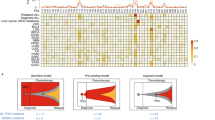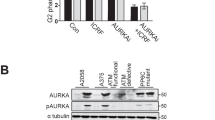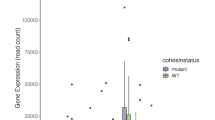Abstract
Chemotherapeutic regimes involving alkylating agents, such as methylators and crosslinking nitrogen mustards, represent a major risk factor for acute myeloid leukaemia. A high frequency of microsatellite instability and evidence of MSH2 loss in alkylating chemotherapy-related acute myeloid leukaemia (t-AML) suggests that DNA mismatch repair (MMR) dysfunction may be an initiating event in disease evolution. Subsequent accumulation of secondary genetic changes as a result of DNA MMR loss may ultimately lead to the gross chromosomal abnormalities seen in t-AML. Homologous recombination repair (HRR) maintains chromosomal stability by the repair of DNA double-strand breaks, and is therefore a possible target for deregulation in MMR dysfunctional t-AML. In order to test this hypothesis Msh2- proficient and -deficient murine embryonic stem (ES) cells were used to examine the effects of MMR status and methylating agent treatment on cellular expression of DNA double-strand break repair genes. HRR gene expression was significantly deregulated in Msh2 null ES cell clones compared to wild-type clones. Furthermore, some Msh2 null clones expressed high levels of Rad51 specifically, a critical component of HRR. Such Rad51 superexpressing clones were also observed when expression was determined in monocytic myeloid cells differentiated from ES cells. A deregulated HRR phenotype could be partially recapitulated in MMR-competent wild-type cells by treatment with the methylating agent, N-methyl-N-nitrosourea. Furthermore, treatment with melphalan, a leukaemogenic DNA crosslinking chemotherapy nitrogen mustard predicted to elicit HRR, selected against cells with deregulated HRR. These data suggest a t-AML mechanism whereby DNA MMR loss promotes the emergence of HRR gene superexpressing clones, with concomitant chromosomal instability. However, melphalan selection against clones with deregulated HRR suggests that persistence and expansion of unstable clones may require additional genetic alterations that promote cell survival.
This is a preview of subscription content, access via your institution
Access options
Subscribe to this journal
Receive 50 print issues and online access
$259.00 per year
only $5.18 per issue
Buy this article
- Purchase on Springer Link
- Instant access to full article PDF
Prices may be subject to local taxes which are calculated during checkout






Similar content being viewed by others
References
Baumann P, West SC . (1997). EMBO J 16: 5198–5206.
Ben-Yehuda D, Krichevsky S, Caspi O, Rund D, Polliack A, Abeliovich D et al. (1996). Blood 88: 4296–4303.
Beranek DT, Weis CC, Swenson DH . (1980). Carcinogenesis 1: 595–606.
Bignami M, O'Driscoll M, Aquilina G, Karran P . (2000). Mutat Res 462: 71–82.
Boulton E, Cole C, Knight A, Cleary H, Snowden R, Plumb M . (2003). Blood 101: 2349–2354.
Casorelli I, Offman J, Mele L, Pagano L, Sica S, D'Errico M et al. (2003). DNA Repair (Amst) 2: 547–559.
Chaney S, Sancar A . (1996). JNCI 88: 1346–1360.
Clark DJ, Meijne EI, Bouffler SD, Huiskamp R, Skidmore CJ, Cox R et al. (1996). Genes Chromosomes Cancer 16: 238–246.
Clarke D, Vegiopoulos A, Crawford A, Mucenski M, Bonifer C, Frampton J . (2000). Oncogene 19: 3343–3351.
Davies S . (2001). Med Pediatr Oncol 36: 536–540.
Delwail V, Jais J, Colonna P, Andrieu J . (2002). Br J Haematol 118: 189–194.
Duckett DR, Drummond JT, Murchie AI, Reardon JT, Sancar A, Lilley DM et al. (1996). Proc Natl Acad Sci USA 93: 6443–6447.
Engelward BP, Allan JM, Dreslin AJ, Kelly JD, Wu MM, Gold B et al. (1998). J Biol Chem 273: 5412–5418.
Gaymes TJ, Mufti GJ, Rassool FV . (2002). Cancer Res 62: 2791–2797.
van Gent DC, Hoeijmakers JH, Kanaar R . (2001). Nat Rev Genet 2: 196–206.
Giot L, Chanet R, Simon M, Facca C, Faye G . (1997). Genetics 146: 1239–1251.
Glassner B, Rasmussen L, Najarian M, Posnick L, Samson L . (1998). Proc Natl Acad Sci USA 95: 9997–10002.
Hatch S, Lightfoot HM, Garwacki C, Moore DT, Calvo BF, Woosley JT et al. (2005). Clin Cancer Res 15: 2180–2187.
Hampson R, Humbert O, Macpherson P, Aquilina G, Karran P . (1997). J Biol Chem 272: 28596–28606.
Hofseth L, Khan M, Ambrose M, Nikolayeva O, Xu-Welliver M, Kartalou M et al. (2003). J Clin Invest 112: 1887–1894.
Humbert O, Fiumicino S, Aquilina G, Branch P, Oda S, Zijno A et al. (1999). Carcinogenesis 20: 205–214.
Karran P . (2001). Carcinogenesis 22: 1931–1937.
Karran P, Offman J, Bignami M . (2003). Biochimie 85: 1149–1160.
Kat A, Thilly WG, Fang WH, Longley MJ, Li GM, Modrich P . (1993). Proc Natl Acad Sci USA 90: 6424–6428.
Kawate H, Sakumi K, Tsuzuki T, Nakatsuru Y, Ishikawa T, Takahashi S et al. (1998). Proc Natl Acad Sci USA 95: 5116–5120.
Keller G, Kennedy M, Papayannopoulou T, Wiles MV . (1993). Mol Cell Biol 13: 473–486.
Kim PM, Allen C, Wagener BM, Shen Z, Nickoloff JA . (2001). Nucl Acids Res 29: 4352–4360.
Lee J, Paull T . (2005). Science 308: 551–554.
Liss B . (2002). Nucl Acids Res 30: e89.
Loeb LA . (2001). Cancer Res 61: 3230–3239.
Lowsky R, Magliocco A, Ichinohasama R, Reitmair A, Scott S, Henry M et al. (2000). Blood 95: 1767–1772.
Marmorstein LY, Ouchi T, Aaronson SA . (1998). Proc Natl Acad Sci USA 95: 13869–13874.
Marra G, D'Atri S, Corti C, Bonmassar L, Cattaruzza MS, Schweizer P et al. (2001). Proc Natl Acad Sci USA 98: 7164–7169.
Paull T, Gellert M . (1999). Genes Dev 13: 1276–1288.
Pedersen-Bjergaard J, Andersen MK, Christiansen DH, Nerlov C . (2002). Blood 99: 1909–1912.
Posnick LM, Samson LD . (1999). J Bacteriol 181: 6763–6771.
Qin X, Shibata D, Gerson S . (2000). Carcinogenesis 21: 833–838.
Ramalho-Santos M, Yoon S, Matsuzaki Y, Mulligan RC, Melton DA . (2002). Science 298: 597–600.
Richardson C, Stark JM, Ommundsen M, Jasin M . (2004). Oncogene 23: 546–553.
Sheikhha MH, Tobal K, Liu Yin JA . (2002). Br J Haematol 117: 359–843.
Thirman MJ, Larson RA . (1996). Hematol Oncol Clin North Am 10: 293–320.
Trujillo KM, Yuan SS, Lee EY, Sung P . (1998). J Biol Chem 273: 21447–21450.
Valerie K, Povirk L . (2003). Oncogene 22: 5792–5812.
Wang ZM, Chen ZP, Xu ZY, Christodoulopoulos G, Bello V, Mohr G et al. (2001). J Natl Cancer Inst 93: 1473–1478.
de Wind N, Dekker M, Berns A, Radman M, Te RH . (1995). Cell 82: 321–330.
Worrillow LJ, Travis LB, Smith AG, Rollinson S, Smith AJ, Wild CP et al. (2003). Clin Cancer Res 9: 3012–3020.
Zhu YM, Das-Gupta EP, Russell NH . (1999). Blood 94: 733–740.
Acknowledgements
We thank Fiona Mensah and Alexandra Smith (Epidemiology and Genetics Unit, York University), for their assistance with the statistical analysis, and Sheila O'Connor (Haematological Malignancy Diagnostic Unit, Leeds General Infirmary) for her assistance in monocyte identification. We also acknowledge the excellent technical support provided by Celina Whalley and Barbara Smith (Technology Facility, York University). We also thank Professor Constance Bonifer and Debbie Clarke (Molecular Medicine Unit, University of Leeds), and Professor Hein te Reile (Netherlands Cancer Institute, Amsterdam). This work was supported by the Leukaemia Research Fund.
Author information
Authors and Affiliations
Corresponding author
Rights and permissions
About this article
Cite this article
Worrillow, L., Allan, J. Deregulation of homologous recombination DNA repair in alkylating agent-treated stem cell clones: a possible role in the aetiology of chemotherapy-induced leukaemia. Oncogene 25, 1709–1720 (2006). https://doi.org/10.1038/sj.onc.1209208
Received:
Revised:
Accepted:
Published:
Issue Date:
DOI: https://doi.org/10.1038/sj.onc.1209208
Keywords
This article is cited by
-
Investigating the impact of long term exposure to chemical agents on the chromosomal radiosensitivity using human lymphoblastoid GM1899A cells
Scientific Reports (2021)
-
Molecular biology of therapy-related leukaemias
Clinical and Translational Oncology (2010)
-
Mechanisms of therapy-related carcinogenesis
Nature Reviews Cancer (2005)



